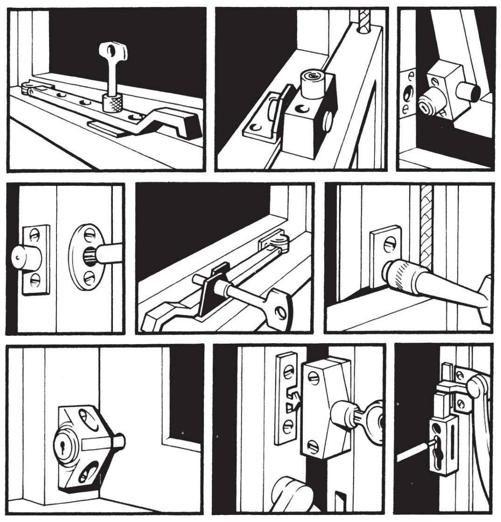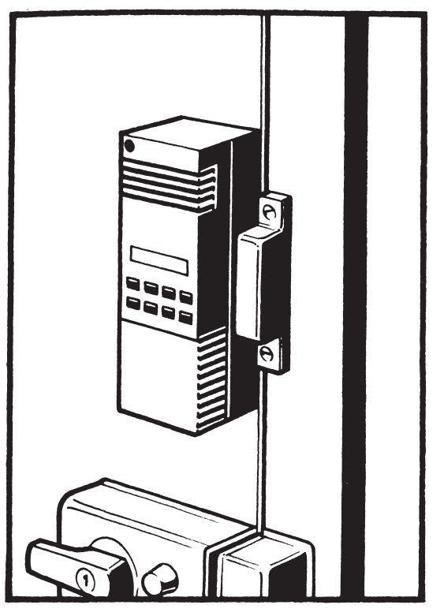SAS Urban Survival Handbook (62 page)
Read SAS Urban Survival Handbook Online
Authors: John Wiseman
Tags: #Health & Fitness, #Reference, #Survival, #Fiction, #Safety, #Self-Help, #Personal & Practical Guides, #General, #Survival Skills

WARNING
You should always ‘lock yourself in’ with a mortise lock – especially when settling down for the evening or going to bed. Intruders have been known to break in and rob a house while the occupants were watching television or sleeping. DON’T FORGET: You will need a key to open the door – and may need to do so in an emergency. When you leave a multi-occupied building, check that you haven’t locked someone in.
‘Entryphones’
If you want to check on callers without actually having to go to the door, instal an audio or CCTV (closed-circuit television) ‘entryphone’. These are becoming increasingly common, especially for multi-occupied buildings. However the voice of an unknown caller would not necessarily give you any clue as to their intentions. A camera is relatively easy to put out of action and may not reveal an accomplice. Consider fitting a spyhole as a useful back-up.
WHO’S THERE?
A door viewer (peephole) – a small lens which gives you a good look at anyone outside the door – is a sensible addition which allows you to check all callers. DON’T forget that if you have a bright light on your side of the door you will block the light as you look through the peephole, making it obvious that you are in. Make sure the viewer has a cover which you can slide open when your head is close to it. Don’t give your presence away by noisy footsteps as you come downstairs or along a hallway.

WARNING
Most peepholes distort the view, even though they allow about 180º vision. If the caller is too close, they may look quite frightening.
- ■
If you are very short or very tall, the comfortable height for you might not give a good view of the caller - ■
A peephole might not let you see someone else lurking behind the caller, or to one side - ■
If in any doubt, do NOT open the door
Limiters/chains
Door limiters, made from toughened steel, are stronger than chains and can act as an additional bolt when the door is closed. A chain won’t deter a violent intruder. Once you’ve opened the door, one kick will tear the chain free. Always use longer screws than those usually supplied with these devices, or they give a false sense of security.
REMEMBER
Check all callers: NEVER let strangers into your house without making sure WHO they are and WHAT their business is. Try NEVER to admit them when you are on your own. Thieves may pose as representatives of gas, water or electricity companies, social workers – even police officers – to gain entry (see SELF-DEFENCE: Attack at home).
They MUST allow you to take their identification from them and close the door. Don’t just call the number on any business card they show. The number could be that of an accomplice. Use the telephone directory!
WINDOW LOCKS
It is preferable to fit locks on ALL windows. Different types are made for different forms of window. It’s something a DIY person could handle, though you may need a locksmith’s help if the frames are plastic or metal, instead of wood.

Most window ‘locks’ use very simple screw mechanisms. There are only a few key shapes – the average burglar is bound to know them all. For particularly vulnerable windows extra precautions must be taken, fitting REAL locks or locking catches. This may be an expensive option – or a pointless one if all the burglar needs to do is break the glass. Fit a grille! Don’t forget that YOU may have difficulty opening the window if it is an emergency escape route.
Accessible windows should be fitted with net curtains, venetian blinds or louvre shutters—anything which prevents an easy view of the contents of the room.
DOGS
 Almost all dogs will act as burglar deterrents – their barking will attract attention. Even a small dog can be aggressive in defending its home against a stranger and can sound ‘bigger’
Almost all dogs will act as burglar deterrents – their barking will attract attention. Even a small dog can be aggressive in defending its home against a stranger and can sound ‘bigger’
than it is! Many dogs are friendly to almost anyone who shows interest in them and will be no actual defence at all – but their presence may be enough to make the opportunist thief look elsewhere.
Large dogs and breeds originally bred as fighting or guard dogs may be both psychological deterrents and practical defenders. All dogs need training, but with powerful breeds it is particularly important for you to be able to control and trust them. Dogs are pack animals and need a leader, or they may take over this role and become uncontrollable. Some have a strong sense of territory and will even deny access to your friends.
Domestic pets (especially when there are children about) should never be encouraged to be overly aggressive. Professional training classes are advisable for both dog and owners.
ALARM SYSTEMS
Just the sight of an alarm box may discourage a casual burglar from attempting to break in. Professional burglars know how to deal with alarms and will do so when they think the job is really worth the effort. Many people feel that the sight of an alarm box on the front of the house alerts thieves to the fact that you have possessions that you think are worth protection!
If the burglar is not aware that there is an alarm system, the surprise of bells, sirens and flashing lights may scare them off—at least, they will try to get away as fast as possible. Alarms will alert you (if you are in), and everyone in the neighbourhood, that a robbery is taking place.
When choosing an alarm system, remember that you will have to set it each time you leave the house or go to bed. If the setting process is fiddly or has to be done in a hurry to avoid sounding the alarm, you might get very fed up with the system. There is no point in installing an alarm if you do not use it. Domestic systems are not usually very complicated, but try to ensure that yours offers some flexibility and can be adjusted to suit your needs.
If you think the main value of a burglar alarm is its deterrent effect, fit a dummy alarm box on an outside wall. It’s cheaper and much less hassle than having the whole works!

SIMPLE ALARMS
A simple battery-operated alarm will alert you if someone opens a door or window. To set the alarm you either turn a key or punch a digital code. If you live above ground in an apartment block with only one entry door to your property and you want to be alerted if someone enters a garage or outbuilding, or if you want to restrict access to part of your home (a workshop, perhaps), an alarm like this could be ideal.
Types of system
Installing an alarm system provides a greater feeling of security but is no substitute for strong locks/grilles and other security measures. Alarm systems are constantly being updated—take your time to choose one that meets your requirements. Most alarm systems are made up of the same elements, although the way in which these are linked varies considerably. The three main options are:
- ◑ Open circuit. When the circuit is completed by a detector/ triggering device the alarm sounds. To prevent deactivation by the cutting of a wire, multicore wires are used which contain a back-up circuit that reacts to tampering.
- ◑ Closed circuit. When the circuit is broken by a detector/triggering device, the alarm sounds. Back-up circuits prevent deactivation by attempting to bridge circuits with additional wires.
- ◑ Wireless systems. Each sensor/triggering device is a small short-range transmitter—if the control panel receives a signal from any of them, the alarm sounds.
Control unit
This is the ‘brain’ of the system. Options may include:
- ◑ Being able to switch the whole system on/off (with a key or digital keypad).
- ◑ Being able to deactivate sections of the system, which would allow you, for instance, to protect the lower floor of a home while the occupants are using the upper floor.
- ◑ Adjustments of the time allowed to leave the building and close the main door.
- ◑ Fail-safe devices and tamper alarms, if any attempt is made to deactivate the control panel.
- ◑ A back-up power source, which cuts in if there is a power failure for any reason.
Detectors/sensors
There are numerous triggering devices available, allowing you to choose a combination to protect your home in many ways.
Magnetic switches
will alert you if doors or windows have been opened. Some are surface mounted, but there are ‘hidden’ versions which fit into the door or window and frame. There are ways to ‘fool’ them. False alarms are unlikely.
Vibration detectors
will alert you if a door or window is subjected to slight movement—a door may be kicked or someone may attempt to break a window. They need to be adjusted to allow for ‘normal’ vibrations to avoid false alarms caused by sudden gusts of wind or heavy traffic.
Foil strips
on windows (in closed-circuit systems) break contact if the glass is broken.
Pressure mats
are activated by the weight of a person treading on them. They are usually placed under doormats and carpets in places that no one can avoid. Frequent traffic over them, in places such as the bottom of the stairs, may wear them out or cause their shape to show up through the carpet.
Movement sensors
which emit infra-red, radio or ultrasonic waves are triggered by anything which comes within their field. False alarms may be caused by children, pets—anything of any size which moves—a tumbling cushion, a large moth near the sensor. Most movement sensors are adjustable—but take care not to render them too insensitive.
Movement sensors are advisable for external use. On your doorstep, a light can be arranged to come on as anyone approaches the door. Powerful floodlights can be activated to expose anyone who attempts to approach your home from the front, sides or rear.